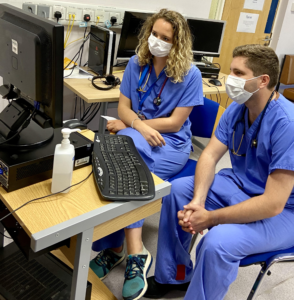Dr Ben Pyrke (Senior House Officer at University Hospital Llandough, Cardiff, UK), Dr Harriet White (Senior House Officer at University Hospital Llandough, Cardiff, UK), Dr Badr Abdalla(Clinical Fellow in Gastroenterology at University Hospital Llandough, UK), Dr Gwen Cartwright (Foundation Doctor Year 1 at University Hospital Llandough, Cardiff, UK)
Pre-COVID-19 we relied on face-to-face consultations, bedside family updates and discharge meetings to assist us in communicating with patients and their relatives. We could confidently set the tone, adapt our body language, respond to shifts in mood and take note of family dynamics. We could offer cups of tea, a box of tissues or a hand to hold.
Over the last 6 months, the COVID-19 pandemic has swept across the world, presenting healthcare staff with a multitude of novel challenges.1 One of these has been in maintaining effective communication with patients’ families due to necessary social distancing and visiting restrictions.2
In the outpatient setting, these restrictions have catalysed a long-awaited shift in practice to video-conference style clinics across all areas.3,4,5,6 Pre COVID-19, attempts at implementation have been poor.7
But what about the inpatient population? How does this new era of digital healthcare translate into our workforce, and into the busy, technologically starved ward environment? 6
At University Hospital Llandough, our team investigated the adoption of telephone and video technology on an acute medical COVID-19 ward.
Communication in challenging times
As junior doctors, we rarely receive formal teaching on telephone and video communication. A local questionnaire of junior doctors found 100% had had difficult discussions via telephone during the pandemic, but 82% had no formal training.
On asking relatives for feedback, 63% did not feel well informed of their relatives’ admission. They found it difficult to speak to doctors, particularly in difficult conversations where non-verbal cues are key. They felt the onus was on them to initiate contact, which added to the psychological strain of being separated from loved ones. We strove to improve both feedback from patients’ relatives, and confidence and education within our cohort of doctors, through the implementation of video communication and small group teaching.
We arranged teaching on communication, with a specific focus on breaking bad news virtually, this was provided by Dr Anthony Byrne (Palliative Care Consultant, UHL). Using NHS-approved software AccuRx on tablet devices we were able to facilitate “video-visiting”. Families could book video calls with a doctor, something we particularly encouraged to assist with difficult conversations. AccuRx works by sending a link to any video enabled device and needs no additional software to run. It has proved straightforward and easy to implement.
‘Preparation is key’
Preparation emphasises the importance of building a rapport with relatives prior to any deterioration whilst allowing time for the doctor to summarize the patient journey so far. Regular pauses to check understanding are even more important than in person to facilitate questions and to help establish their response in the absence of non-verbal cues.
In patient-relative video calls, having another member of staff present throughout the call can support the patient and provide reassurance. This visual contact empowers us to provide greater empathy and support to the family with facial expression and tone. One relative found the video-visit allayed their fears, reporting ‘seeing oxygen therapy and a calm, caring ward environment’ was much better than the image they had created in their imagination.
Challenges we faced were in ensuring regular updates and overcoming poor Wi-Fi coverage and tablet availability. Embedding communication into the ward round and creating slots that relatives could book into, helped to ensure doctor availability and preparedness. In those not comfortable with the use of video software due to lack of confidence/education, we encouraged the involvement of other family members to assist with the technology.
Feedback and Education
Family discussion is labour intensive and often falls to the bottom of the long list of ward jobs. With the introduction of regular telephone updates, we found that it can be more personal, empathetic and effective. Relatives reported increased understanding in regards to the admission, reassurance around the care their relative is receiving and greater confidence and trust in the unit. Feedback from “video-visits” has been complimentary, with another relative reflecting that ‘seeing their loved one unwell, unresponsive but appearing comfortable and cared for’ was a positive experience.
We would therefore recommend that teams working within inpatient settings adopt regular family updates as part of the daily ward routine. During restricted visiting, we encourage the use of video communication due to the additional benefits it provides. We suggest that education around this style of communication is initiated locally to help junior doctors to work out of their comfort zone in an already challenging environment. The smiles and relief of family and patients in difficult times are testament to what can be achieved.
References:
- Shi Y, Wang G, Cai XP, et al. An overview of COVID-19. J Zhejiang Univ Sci B. 2020;21(5):343-360. doi 10.1631/jzus.B2000083
- Rockwell KL, Gilroy AS. Incorporating telemedicine as part of COVID-19 outbreak response systems. Am J Manag Care. 2020;26(4):147-148. doi:10.37765/ajmc.2020.42784
- Royal College of Physicians. Outpatients: the future – adding value through sustainability. London: RCP, 2018.
- Portnoy J, Waller M, Elliott T. Telemedicine in the Era of COVID-19. J Allergy Clin Immunol Pract. 2020;8(5):1489-1491. doi:10.1016/j.jaip.2020.03.008
- Greenhalgh T, Wherton J, Shaw S, Morrison C. Video consultations for covid-19. BMJ. 2020 Mar 12;368:m998. doi: 10.1136/bmj.m998
- Samuel T, Beck K, Symonds R. Video consultations in UK primary care in response to the COVID-19 pandemic British Journal of General Practice. 2020; 70(694): 228-229. doi: 10.3399/bjgp20X709505.
- Comptroller and Auditor General, 2020. Digital Transformation In The NHS. [online] London. Available at: <https://www.nao.org.uk/report/the-use-of-digital-technology-in-the-nhs/> [Accessed 15 July 2020]
